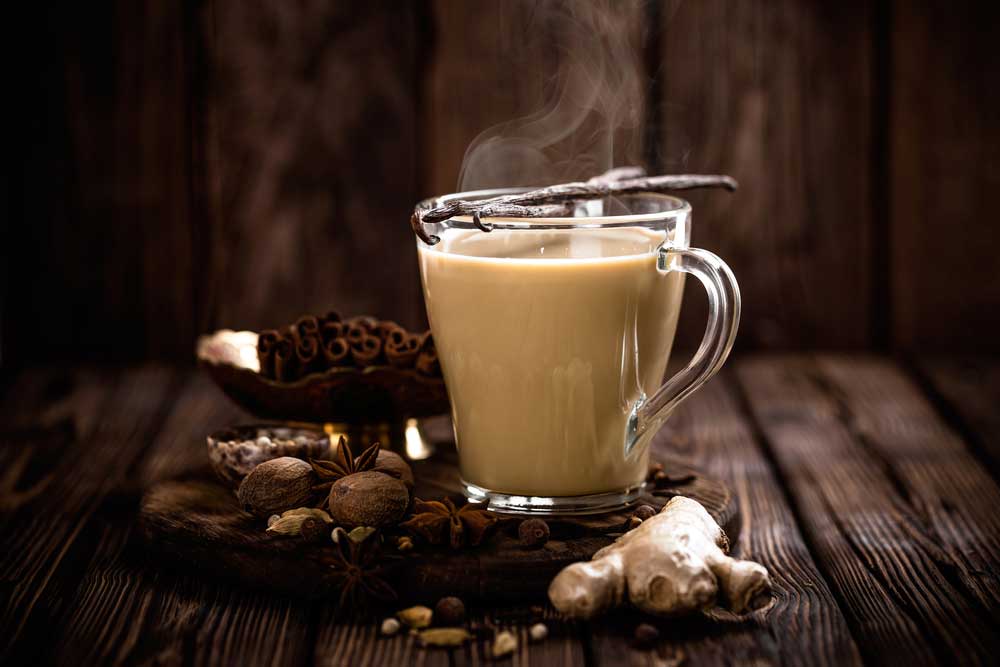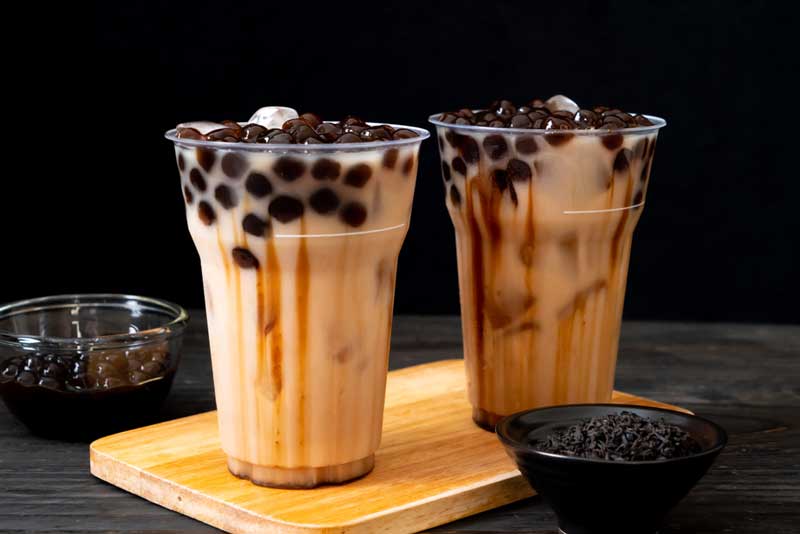What does milk tea taste like? Are you yet to try this popular drink and curious to know what it tastes like?
The origin of milk tea can be traced to China, where it is a popular drink.
For people who want delicious but not overwhelming beverages, milk tea is made from black or green teas that are carefully blended. The kind of milk used affects the tea’s flavor.
If you prefer sweet milk tea, it can be sweet; if you like it more flavorful and savory, it can be sour. For sweetness, it is traditionally prepared with black tea, vanilla, condensed, or coconut milk.
The addition of fruit juice is popular, and milk tea can be served hot or cold. Depending on the weather, many people early anticipate their daily cup of milk tea, which is warm, soothing, and energizing right away.
This article will describe the authentic flavors of milk tea. Let’s begin by briefly examining milk tea and its various flavors. Do read on!
What is Milk Tea?
A tea company In Taiwan began to sell milk tea to North America in 1980. This was when the Western world first came in contact with milk tea.
Traditionally in China and Taiwan, milk teas can be served cold, like soft drinks, or hot. However, serving milk tea with ice in Asia is a command practice.
The practice of serving milk teas with ice cubes can come in handy during warm months as they can serve as excellent options for refreshment.
Milk teas are usually made by soaking green or black teas in milk and adding sugar. Condensed milk is generally added to give it an authentic milk tea taste. Then it is served hot or with ice cubes as so desired.
The sweet taste of milk teas is one of the main reasons it has become popular. Also, several people enjoy milk teas in warm conditions as it provides delightful refreshment.
What better way to get started daily than a cup of milk tea? Many people pick milk tea over coffee because it provides the needed boost without too much caffeine.
What Does Milk Tea Taste Like?
Drinks like milk tea have gained popularity across the globe, but What does milk tea taste like? It tastes similar to the tea you are already familiar with but slightly sweeter. Although oolong, white, and green teas can also be utilized, black teas are typically used to make milk teas.
Condensed milk that has been sweetened makes milk tea creamy and thick. Additionally, it can be enhanced with various substances, including spices, herbs, and fruits.
Green tea or black tea leaves are typically used as the base of milk tea to produce a smooth, creamy beverage. Milk tea can be further sweetened by adding ice cubes or fruit syrup. Milk tea is frequently prepared with flavorings like sugar or honey.
You can discover a variety of milk tea flavors at your neighborhood coffee shop. While some employ already-prepared liquids or powders, some are manufactured from the bottom up. The black tea variation of milk tea is the most popular kind.
But you can also find oolong, green tea, and other varieties in your neighborhood shop. A fairly common beverage in the Pacific Islands and Asia is milk tea. Typically, tea leaves are steeped in water before being combined with sugar and milk.
There are typically two types of milk tea: canned and fresh. Conventional tea leaves are soaked in hot water to make fresh milk tea. The aroma and taste of the leaves are released while they soak.
After that, they are combined with sugar, evaporated milk, and sweet condensed milk. It is a delicious, creamy beverage that can be cold or hot.
The same process is used to make canned milk tea as fresh milk tea. Due to how they are prepared, canned milk tea has less liquid and more sugar; it is usually sweeter than its fresh counterpart. Additionally, it includes flavoring ingredients like chocolate syrup and strawberry to improve its flavor and scent.
Also Read: How hot is Wasabi? (Explained)
Different Types of Traditional Milk Tea
Thai milk tea, Masala Chai, and Hong Kong-style milk tea are a few classic milk tea varieties that are the most similar to the original. Thai milk tea is significantly sweeter than Hong Kong-style milk tea since it contains more sugar. Sweetened condensed milk is employed in both Thai and Hong Kong-style teas. Black tea is spiced up in both Masala Chai and Thai milk tea.
Hong Kong Style Milk Tea
This version is created using a highly concentrated brew of Ceylon Orange Pekoe tea, which is then served hot and combined with sweetened, condensed, and evaporated milk. Chinese Orange Pekoe offers a malty and medium-bodied taste, often accompanied by hints of chocolate. On the other hand, Sri Lankan Ceylon tea presents a subtly refreshing citrus taste. Sweetened condensed and evaporated milk contributes to a fairly sweet taste and a thick, opaque texture.
Thai milk tea
Thai tea, a traditional milk tea based on black tea, is known for its exceptionally sweet taste. It is created by steeping strongly brewed Ceylon tea infused with various spices, including tamarind, cardamom, vanilla bean, and cinnamon. It is combined with sugar and sweetened condensed milk to enhance its sweetness. Optionally, coconut or evaporated milk can be included, and the tea is usually offered over ice.
This variety of milk tea offers a delightful blend of crispy citrus, vanilla, malt flavor, warm spices, and creamy milk. Among these, vanilla stands out as the most prominent note. It is worth noting that Thai tea may sometimes exhibit a vibrant orange hue due to the incorporation of food coloring.
Masala Chai
Thai tea’s distinctive warm spice profile is also present in Masala Chai, accompanied by additional flavors such as ginger, nutmeg, clove, ginger, peppercorn, and coriander. In the preparation of Masala Chai, whole spices are boiled together with milk and Assam black tea., After cooking, it is strained, and sugar is added.
Assam tea, known for its robust and malty characteristics, contributes a bold briskness and a subtle astringency to Masala Chai. It offers nutty caramel undertones that add to its flavor profile. Compared to Thai tea, Masala Chai is spicier, primarily due to the presence of peppercorn and ginger, providing a peppery spice that imparts a comforting warmth to the belly and mouth. It is worth noting that Masala Chai is a spicier milk-based beverage in contrast to its counterpart, Chai Latte, which is sweeter and lighter.

Health Benefits of Milk Tea
In Asia, milk tea has gained immense popularity as a widely consumed beverage, often as a substitute for coffee and regular tea. It has become an integral part of the daily diet in many Asian cultures.
Throughout history, diverse societies have enjoyed milk tea, and it holds significant cultural and culinary value. Besides its cultural significance, milk tea offers several health benefits worth mentioning. One notable advantage is its calcium content, crucial in maintaining optimal bone health. By consuming milk tea, individuals can support the development of nerve cells, teeth, and strong bones. Interestingly, milk tea surpasses regular milk in terms of calcium content, making it a favorable choice for those seeking to increase their calcium intake compared to other milk varieties.
In addition to its calcium content, milk tea is a source of vitamin D, which plays a crucial role in enhancing calcium absorption in the body. By consuming vitamin D through milk tea, individuals can facilitate the utilization of minerals obtained from food sources and release them from storage for various bodily functions.
Milk tea is also rich in flavonoids, which help in managing inflammation. These compounds contribute to reducing inflammation by regulating cholesterol levels and blood sugar. Consuming milk tea with its flavonoid content may help lower the risk of inflammation-related ailments, including stroke, heart disease, and other inflammatory conditions.
Moreover, the enzymes found in milk tea can aid in improving digestion. These enzymes work to break down large carbohydrates, enhancing the body’s ability to absorb nutrients more efficiently.
Indeed, milk tea is not only a satisfying beverage but also holds the potential to provide various health benefits. With its combination of digestive enzymes, flavonoids, and vitamin D, milk tea offers a holistic approach to wellness and enjoyment. It serves as a source of nourishment while contributing to improved calcium absorption, reduced inflammation, and enhanced digestion. Embracing milk tea as part of a balanced diet can be a delightful way to support overall well-being.
Frequently Asked Questions-What Does Milk Tea Taste Like?
How Would You Describe Milk Tea?
Milk tea is exactly as its name suggests: it is prepared by adding milk to tea. This simple combination introduces a smooth and moderately sweet element to the inherent bitterness often found in teas like black tea. The versatility of milk tea allows for the creation of various delightful concoctions, such as bubble tea or masala chai tea. Whether adding tapioca pearls in bubble tea or infusing aromatic spices in masala chai, milk tea offers a wide range of possibilities to suit different tastes and preferences.
What Makes Milk Tea Taste Better?
The addition of honey to tea is incredibly delightful, and honey has always been a popular pairing with milk due to its harmonious flavors. You can substitute sugar with alternative sweeteners such as molasses, honey, or even a small amount of maple syrup. Any sweetener of your choice is likely suitable.
What Are the Unique Features of Milk Tea?
Milk tea exhibits a property that helps reduce stress levels. Consuming tea is linked to fostering positive emotions and inducing physical and mental relaxation due to L-theanine, a compound in black and green tea. Additionally, milk tea contains caffeine, which can provide a rejuvenating effect on the body, albeit in small quantities.
Also, Check out: Is Canned Chicken Cooked? (Everything to Know) and What does Sea Grapes Taste like? (Full Details)
Conclusion-What Does Milk Tea Taste Like?
This article has outrightly answered the question, “What does milk tea taste like?”
In conclusion, Milk tea has a distinct and enjoyable taste that combines the flavors of tea and milk. The exact taste can vary depending on the specific type of tea used, the preparation method, and the ratio of tea to milk.
In general, milk tea offers a creamy and smooth texture with a subtle sweetness from the milk. The tea contributes its unique flavor profile, ranging from delicate and floral notes in green tea to rich and malty undertones in black tea.
The combination of tea and milk creates a harmonious blend often described as soothing, comforting, and satisfying to the palate.

